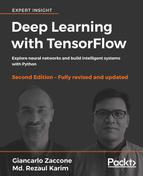In this chapter, we introduced CNNs. We have seen that CNNs are suitable for image classification problems, making the training phase faster and the test phase more accurate.
The most common CNN architectures have been described: the LeNet-5 model, designed for handwritten and machine-printed character recognition; AlexNet, which competed in the ILSVRC in 2012; the VGG model, which achieves a top-5 test accuracy of 92.7% in ImageNet (a dataset of over 14 million images belonging to 1,000 classes); and finally the Inception-v3 model, which was responsible for setting the standard for classification and detection in the ILSVRC in 2014.
The description of each CNN architecture was followed by a code example. Also, the AlexNet network and VGG examples have helped to explain the concepts of the transfer and style learning techniques.
Finally, we built a CNN to classify emotions in a dataset of images; we tested the network on a single image and evaluated the limits and the quality of our model.
The next chapter describes autoencoders: these algorithms are useful for dimensionality reduction, classification, regression, collaborative filtering, feature learning, and topic modeling. We will carry out further data analysis using autoencoders and measure classification performance using image datasets.
